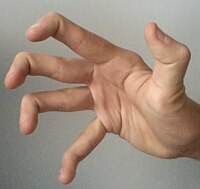
Photo from wikipedia
Patients with hypermobility disorders of the jaw joint experience joint sounds and jerky movements of the jaw. In severe cases, a subluxation or luxation can occur. Clinically, hypermobility disorders should… Click to show full abstract
Patients with hypermobility disorders of the jaw joint experience joint sounds and jerky movements of the jaw. In severe cases, a subluxation or luxation can occur. Clinically, hypermobility disorders should be differentiated from disc displacements. With biomechanical modelling, we previously identified the anterior slope angle of the eminence and the orientation of the jaw closers to potentially contribute to hypermobility disorders. Using cone-beam computed tomography (CBCT), we constructed patient-specific models of the masticatory system to incorporate these aspects. It is not known whether the clinical diagnosis of hypermobility disorders is associated with the prediction of hypermobility by a patient-specific biomechanical model. Fifteen patients and eleven controls, matched for gender and age, were enrolled in the study. Clinical diagnosis was performed according to the Diagnostic Criteria for Temporomandibular Disorders (DC/TMD) and additional testing to differentiate hypermobility from disc displacements. Forward simulations with patient-specific biomechanical models were performed for maximum opening and subsequent closing of the jaw. This predicted a hypermobility disorder (luxation) or a control (normal closing). We found no association between the clinical diagnosis and predictions of hypermobility disorders. The biomechanical models overestimated the number of patients, yielding a low specificity. The role of the collagenous structures remains unclear; therefore, the articular disc and the ligaments should be modelled in greater detail. This also holds for the fanned shape of the temporalis muscle. However, for the osseous structures, we determined post hoc that the anterior slope angle of the articular eminence is steeper in patients than in controls.
Journal Title: Journal of Oral Rehabilitation
Year Published: 2018
Link to full text (if available)
Share on Social Media: Sign Up to like & get
recommendations!